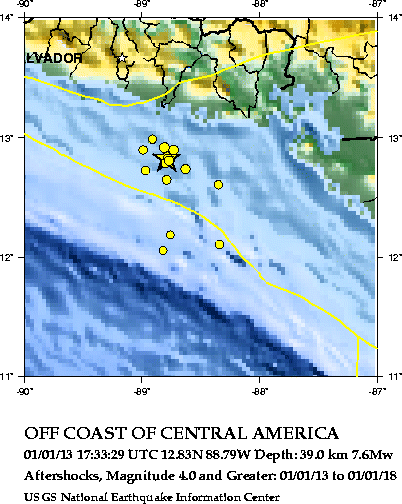Aftershocks Magnitude 4.0 and Greater

2001/01/13 20:56:19 12.11N 88.34W 33.0 4.7 2001/01/14 08:28:14 12.82N 88.75W 33.0 4.1 2001/01/14 11:09:11 12.06N 88.82W 33.0 4.6 2001/01/14 22:41:26 12.92N 88.81W 33.0 5.5 2001/01/14 22:47:52 12.83N 88.78W 33.0 5.1 2001/01/15 00:22:50 12.65N 88.79W 33.0 5.0 2001/01/15 00:50:09 12.73N 88.97W 33.0 4.7 2001/01/15 05:09:05 12.79N 88.80W 33.0 5.0 2001/01/15 12:20:03 12.74N 88.63W 33.0 5.2 2001/01/16 04:38:45 12.61N 88.35W 33.0 4.7 2001/01/16 08:22:08 12.81N 88.77W 33.0 5.2 2001/01/16 10:58:13 12.90N 88.73W 33.0 5.7 2001/01/16 11:24:29 12.90N 88.99W 33.0 4.9 2001/01/16 23:32:40 12.19N 88.76W 33.0 4.4 2001/01/17 01:40:15 12.99N 88.91W 33.0 4.9
From experience with earthquakes around the world, we know that there are likely to be aftershocks. Some of the aftershocks may be large enough to cause additional damage. Buildings that have already been damaged by an earlier earthquake are at highest risk from damage due to a future aftershock. We also know from past experience that the number of aftershocks will decrease over the next few months. There might be short episodes of higher activity, but the overall trend will be for fewer aftershocks as time goes by. Seismologists are not able to predict the timing and sizes of individual aftershocks.
На основную страницу Список землетрясений
URL: http://zeus.wdcb.ru/wdcb/sep/strong/20010113/aftershok.htmlLast revision February 15, 2001